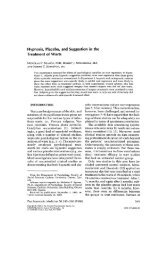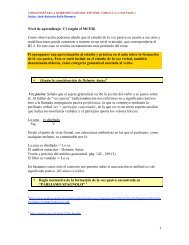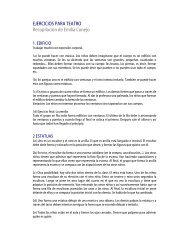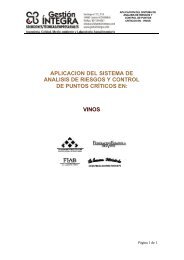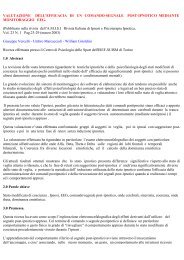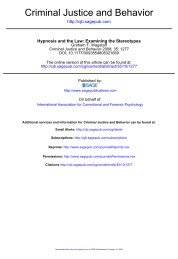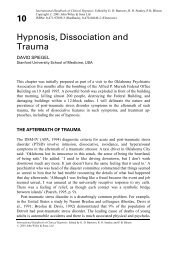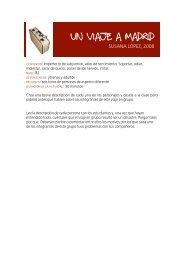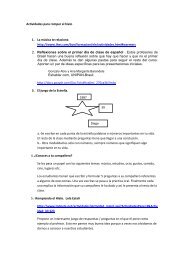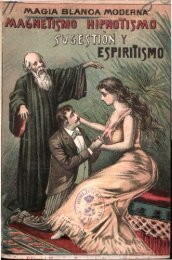Orne, M.T. The use and misuse of hypnosis in court. International ...
Orne, M.T. The use and misuse of hypnosis in court. International ...
Orne, M.T. The use and misuse of hypnosis in court. International ...
Create successful ePaper yourself
Turn your PDF publications into a flip-book with our unique Google optimized e-Paper software.
<strong>Orne</strong> 1979 IJCEHhttp://www.sas.upenn.edu/psych/history/orne/orneijceh19794311341.html13 de 23 19/03/2012 17:24about the validity <strong>of</strong> these statements.When Facts are Not Known or Presumed<strong>The</strong>re are many cases <strong>in</strong>volv<strong>in</strong>g a victim or a witness to a crime who cannot recall potentially importantdetails <strong>and</strong> where the enforcement authorities are equally <strong>in</strong> the dark. In cases <strong>of</strong> assault, for example,<strong>hypnosis</strong> has made it possible for the victim to recall the assailant's appearance, enabl<strong>in</strong>g police artists todraw a reasonable likeness. To the extent that the victim or witness, police, artist, <strong>and</strong> hypnotist alikeshare no preconceived bias about what might have occurred, the situation approaches the ideal case for<strong>hypnosis</strong> to be most appropriately employed: to develop <strong>in</strong>vestigative leads.Hypnotic suggestions may directly or <strong>in</strong>directly enhance memory by provid<strong>in</strong>g contextual cues, <strong>and</strong> therelaxed environment <strong>of</strong> a sensitively conducted session may help dim<strong>in</strong>ish the anxiety which otherwise<strong>in</strong>terferes with attempts to recall. Several cases <strong>of</strong> this type are described by Kroger <strong>and</strong> Douce (1979).Many <strong>of</strong> the limitations <strong>of</strong> the technique--even under such circumstances--have been emphasized earlier,while other pitfalls are described by Kroger <strong>and</strong> Douce. Given appropriate care, however, <strong>hypnosis</strong> hasprovided important new <strong>in</strong>formation to the authorities <strong>in</strong> many <strong>in</strong>stances. If the sole purpose <strong>of</strong> thehypnotic session is to provide clues which ultimately lead to <strong>in</strong>crim<strong>in</strong>at<strong>in</strong>g evidence, the fact that <strong>hypnosis</strong>was orig<strong>in</strong>ally employed becomes irrelevant. However, if there is even the vaguest possibility thathypnotically enhanced recall is to be <strong>use</strong>d <strong>in</strong> <strong>court</strong>, it is essential that the entire contact <strong>of</strong> the hypnotistwith the subject be videotape-recorded <strong>in</strong> order to allow an <strong>in</strong>dependent assessment <strong>of</strong> the eventspreced<strong>in</strong>g, dur<strong>in</strong>g, <strong>and</strong> follow<strong>in</strong>g the hypnotic session to determ<strong>in</strong>e whether or not the memories mighthave <strong>in</strong>advertently been guided by cues <strong>in</strong> the situation.When Significant Facts are Known or PresumedAn <strong>in</strong>creas<strong>in</strong>g number <strong>of</strong> <strong>in</strong>stances are f<strong>in</strong>d<strong>in</strong>g their way <strong>in</strong>to law <strong>court</strong>s where <strong>hypnosis</strong> is <strong>use</strong>d to help"refresh" the memory <strong>of</strong> a witness or victim about aspects <strong>of</strong> a crime which are known to the authorities,the media, or the hypnotist <strong>and</strong> may <strong>in</strong>volve presumed facts that <strong>in</strong> one way or another have been madeavailable to the subject. Of course, the witness or victim cannot testify on this matter unless he is able toremember it personally. Particularly when the <strong>in</strong>terrogation foc<strong>use</strong>s on some relevant detail <strong>and</strong> <strong>in</strong>volveslead<strong>in</strong>g questions, there is the greatest likelihood <strong>of</strong> mischief. A "memory" can be created <strong>in</strong> <strong>hypnosis</strong>where none existed before. While cases <strong>of</strong> this type were once rare, there has329 USE AND MISUSE OF HYPNOSIS IN COURTbeen a dramatic <strong>in</strong>crease <strong>in</strong> the number <strong>in</strong> recent years. Although the source <strong>of</strong> the factual <strong>in</strong>formationmay vary widely, all <strong>of</strong> these cases have the quality that <strong>in</strong>formation is somehow <strong>in</strong>troduced <strong>in</strong>to thesubject's memory which ca<strong>use</strong>s him to testify to the facts as if they were based on prior memories.A Pennsylvania case (United States v. Andrews, 1975) illustrates the k<strong>in</strong>d <strong>of</strong> problem that may occur. Twoseamen recuperat<strong>in</strong>g from illness were work<strong>in</strong>g <strong>in</strong> an <strong>of</strong>fice when a sailor appeared <strong>in</strong> the doorway, aimeda pistol at one <strong>of</strong> the sailors, shot at his head, <strong>and</strong> fled the scene. Fortunately, the <strong>in</strong>tended victim movedquickly <strong>and</strong> suffered only a graz<strong>in</strong>g wound to the ear. When the seamen were shown pictures <strong>of</strong><strong>in</strong>dividuals who might fit the description <strong>and</strong> could have been <strong>in</strong> the area, the victim was unable toidentify anyone. <strong>The</strong> witness, however, identified one <strong>of</strong> the pictures as the assailant. Subsequently, at aprelim<strong>in</strong>ary hear<strong>in</strong>g, the victim was present when the witness identified the defendant as the assailant. <strong>The</strong>victim, however, <strong>in</strong>dicated that the acc<strong>use</strong>d looked like but was not the assailant. <strong>The</strong> victim was thenhypnotized on two occasions by an experienced Navy psychiatrist to facilitate his recall. Dur<strong>in</strong>g the firstsession, he was still unable to make an identification; however, dur<strong>in</strong>g the second session he claimed torecognize the defendant who had previously been identified by the witness as the assailant.At the General Court Martial, the issue <strong>of</strong> the role <strong>of</strong> <strong>hypnosis</strong> was raised by the defense <strong>and</strong> I was askedto testify as an expert. My testimony po<strong>in</strong>ted out that the victim's reaction to <strong>hypnosis</strong> would probably



